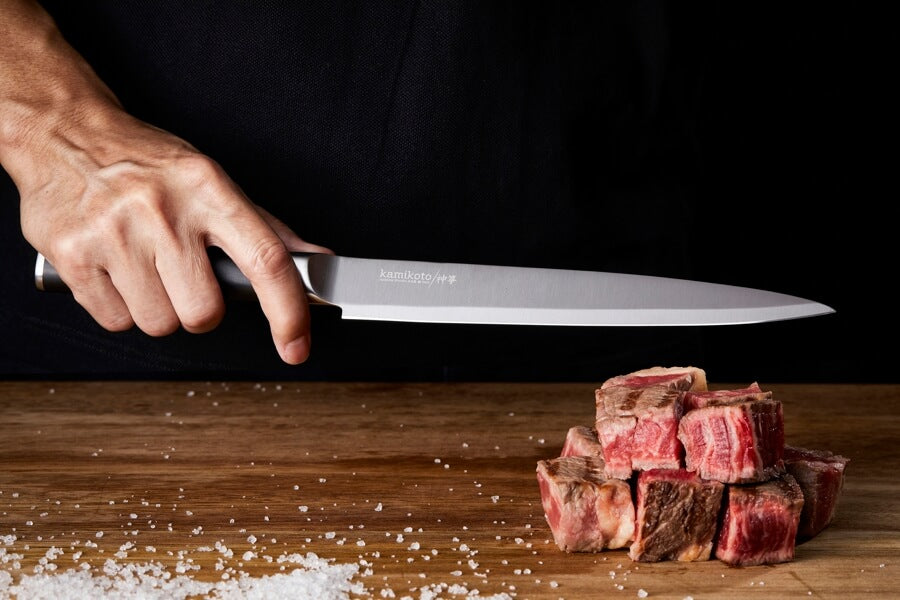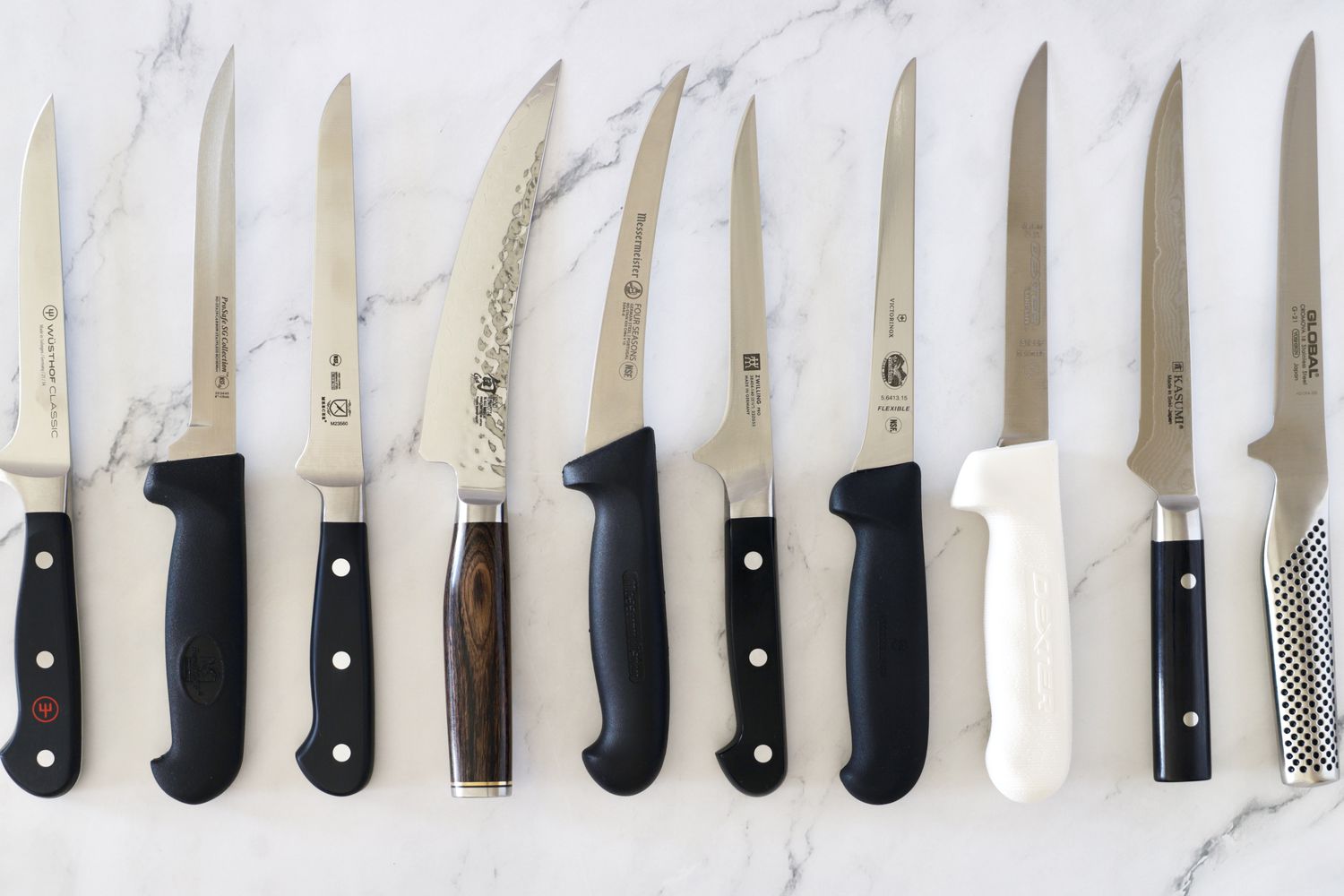A boning knife is used for deboning poultry, meat, and fish, while a steak knife is designed specifically for cutting cooked meats like steak, and a utility knife is a multi-purpose knife that can be used for tasks like cutting meat. When it comes to choosing the right knife for cutting meat, both a boning knife and a utility knife can be suitable options depending on the specific task at hand.
However, a steak knife may not be ideal for deboning or other kitchen tasks beyond cutting cooked meats. Overall, it’s important to consider the specific needs and requirements of your kitchen tasks when deciding between a boning knife, steak knife, or utility knife.
Boning Knife: The Perfect Blade For Precise Meat Cutting
When it comes to cutting meat with precision, nothing beats the performance of a boning knife. Specially designed for the task, a boning knife is an essential tool for professional chefs and home cooks alike. In this section, we will explore the design, features, and techniques of using a boning knife effectively for meat cutting.
Overview of the boning knife’s design and purpose
The boning knife features a narrow and flexible blade, usually ranging from 5 to 7 inches in length. The thin and sharp blade allows for precise maneuverability, making it ideal for removing bones, skin, and tendons from various cuts of meat. Its pointed tip helps in navigating around joints and ligaments with ease. The handle of a boning knife is designed for a comfortable grip, allowing the user to have full control during intricate cutting tasks.
Key features and benefits of using a boning knife for meat cutting
The boning knife offers several key features and benefits that make it the perfect choice for meat cutting:
- Precision Cutting: The narrow and flexible blade of a boning knife enables precise and accurate cuts, ensuring minimal wastage and maximum yield.
- Efficient Bone Removal: The sharp edge and pointed tip of the boning knife make it effortless to separate meat from bones, facilitating easy deboning.
- Versatility: In addition to meat cutting, the boning knife can be used for tasks like filleting fish or trimming fat from poultry.
- Improved Kitchen Safety: The ergonomic handle of a boning knife provides a secure grip, reducing the risk of accidental slips and cuts.
Techniques and tips for using a boning knife effectively
To make the most out of your boning knife, keep in mind the following techniques and tips:
- Choose the Right Blade Type: Select a boning knife with the appropriate blade type based on the meat you are working with. Flexible blades are better suited for delicate cuts, while stiff blades are ideal for tougher meats.
- Make Smooth and Controlled Strokes: Use long, smooth strokes instead of applying excessive force. This helps maintain control and ensures clean cuts.
- Angle the Blade: Angle the blade slightly towards the bone to follow its contours, making it easier to remove meat without wasting any.
- Maintain Sharpness: Keep the blade sharp to enhance its performance. Regularly sharpen and hone the boning knife to ensure optimal cutting ability.
Comparing different types of boning knives available in the market
When it comes to choosing a boning knife, there are various options available in the market. Here’s a comparison of different types of boning knives:
| Type | Blade Length | Flexibility |
|---|---|---|
| Flexible Boning Knife | 5-6 inches | High |
| Stiff Boning Knife | 6-7 inches | Low |
| Curved Boning Knife | 5-6 inches | Varies |
| Narrow Boning Knife | 6-7 inches | High |
Each type of boning knife has its own strengths and suits different cutting tasks. Consider your specific needs and preferences before making a purchase.
With its precise cutting ability, versatility, and ergonomic design, a boning knife is undoubtedly a must-have tool in any kitchen. Whether you’re a professional chef or a cooking enthusiast, investing in a quality boning knife will elevate your meat cutting skills to a whole new level.
Steak Knife: Enhancing The Dining Experience With Perfect Cuts
Steak Knife: Enhancing the Dining Experience with Perfect Cuts
Understanding the unique characteristics of a steak knife
Steak knives are specially designed knives that possess unique characteristics to provide a seamless cutting experience. These knives have sharp serrated edges, which make them ideal for slicing through thick cuts of steak effortlessly. The serrations ensure that the knife effortlessly glides through the meat without tearing or crushing it. Additionally, steak knives often have longer blades than regular knives, allowing for precise and smooth cuts.
How a steak knife enhances the enjoyment of a perfectly cooked steak
A perfectly cooked steak deserves to be enjoyed with the right utensil, and that’s where the steak knife comes in. The sharp and serrated blade of a steak knife ensures that every bite of the tender and juicy steak is as delightful as it should be. Unlike regular knives that might struggle to slice through the meat, a steak knife effortlessly cuts through the steak, maintaining its flavor and texture. By using a steak knife, each bite becomes a pleasure, elevating the overall dining experience.
Factors to consider when choosing the right steak knife
When selecting a steak knife, there are a few important factors to consider:
- Blade Material: Look for steak knives made from high-quality stainless steel to ensure durability and resistance to corrosion.
- Handle Comfort: A comfortable handle allows for a secure grip, enhancing control and preventing accidents.
- Serrated Edge: Ensure that the steak knife has sharp serrations to effortlessly cut through the meat without tearing or crushing it.
- Blade Length: Consider the length of the blade based on personal preference and the thickness of the steaks you usually enjoy.
- Aesthetics: Choose a steak knife that complements your dining set to add an elegant touch to your table setting.
Exploring different steak knife designs and materials
Steak knives are available in a variety of designs and materials, each with its own benefits:
| Design | Material |
|---|---|
| Straight Edge | High Carbon Stainless Steel |
| Serrated Edge | Forged Stainless Steel |
| Hollow-Edge | Ceramic |
| Full Tang | Wooden Handle |
Each design and material offers its own advantages and can cater to different preferences. It is important to choose a steak knife that aligns with your needs and preferences to ensure a delightful dining experience.
Utility Knife: The Versatile Tool For Meat Cutting And Beyond
Utility Knife: The Versatile Tool for Meat Cutting and Beyond
An overview of utility knife’s functionalities and applications
A utility knife is a versatile tool that proves to be especially handy in the kitchen when it comes to meat cutting and other tasks. Its compact size and sharp blade make it suitable for various cutting needs. The utility knife is designed to handle a wide range of kitchen tasks, including slicing, dicing, mincing, and trimming meat, fruits, and vegetables. Its multi-purpose nature makes it a must-have in any kitchen.
Comparing the serrated edge of a utility knife to other meat-cutting knives
One of the notable features of a utility knife is its serrated edge. Unlike a boning knife or a steak knife, which typically have straight edges, the utility knife’s serrated edge provides several advantages. The serrations help grip the surface of the meat, allowing for cleaner and smoother cuts. This is particularly useful when dealing with tougher meat cuts or crusty bread. The serrated edge of a utility knife is designed to minimize the tearing and shredding of food, ensuring precise and efficient cutting.
The benefits and versatility of using a utility knife for various meat-cutting tasks
The utility knife offers several benefits and is highly versatile when it comes to meat-cutting tasks. Firstly, its compact size makes it easy to handle and maneuver, providing better control over the cutting process. Secondly, the sharpness of the utility knife’s blade ensures clean and precise cuts, resulting in visually appealing meat slices. Additionally, the versatility of the utility knife allows it to be used for both raw and cooked meats. Whether you need to slice through a tender steak or carve up a roast, the utility knife is up to the task.
The utility knife’s versatility extends beyond meat cutting. It can also be used in various other kitchen tasks, such as cutting through fruits, vegetables, and even bread. Its compact size and sharp blade make it a go-to tool for any small cutting needs in the kitchen.
Choosing the right utility knife for your kitchen
When choosing a utility knife for your kitchen, it’s essential to consider various factors. Blade material, handle comfort, and overall durability should all be taken into account. Additionally, you may want to consider whether you prefer a straight-edged utility knife or one with a serrated edge, depending on your cutting preferences and needs. It’s recommended to opt for a high-quality utility knife that is well-balanced and offers a comfortable grip, ensuring ease of use and longevity.

Credit: kamikoto.com
Factors To Consider When Choosing The Ultimate Meat-Cutting Tool
Factors to Consider When Choosing the Ultimate Meat-Cutting Tool
When it comes to cutting meat, having the right tool can make all the difference in achieving precise and effortless cuts. There are three main types of knives commonly used for meat cutting: boning knife, steak knife, and utility knife. Each knife type has its own unique features and advantages that cater to specific meat-cutting tasks.
Comparison of Blade Design, Length, Maneuverability, and Weight
| Boning Knife | Steak Knife | Utility Knife |
|---|---|---|
| The boning knife typically has a thin, narrow, and curved blade. This design allows for precise maneuverability and makes it easier to get close to the bone for deboning tasks. | The steak knife often has a straight, narrow blade with a sharp, serrated edge. This design ensures smooth, effortless cuts through cooked meats like steak. | The utility knife features a versatile straight blade, which makes it suitable for a wide range of tasks including meat cutting. Its serrated edge provides added versatility and makes it perfect for slicing through various textures of meats. |
Considering the Flexibility and Strength of the Blade for Different Meat-Cutting Tasks
- For deboning tasks, a boning knife’s flexible blade allows for easy maneuverability around bones and joints, ensuring minimal meat wastage.
- A steak knife’s strong, serrated blade is ideal for cutting through tough cuts of cooked meat without tearing or shredding.
- A utility knife’s combination of flexibility and strength makes it suitable for a variety of meat-cutting tasks, from carving roasts to slicing through tender cuts.
Ergonomics and Handle Design: How They Affect the Overall Performance of the Knife
- Boning knives often have a curved handle that provides a comfortable grip and enhances control during intricate cutting movements.
- Steak knives typically have a sturdy, ergonomic handle that allows for a secure grip, ensuring stability and precision while cutting.
- Utility knives come in a variety of handle designs, catering to personal preferences. The handle should offer a comfortable grip and balance to prevent hand fatigue during extended use.
Reviewing Customer and Professional Ratings and Reviews for Each Knife Type
When choosing the ultimate meat-cutting tool, it can be helpful to consider customer and professional ratings and reviews. By taking into account the experiences and feedback of others, you can gain valuable insights into the performance, durability, and overall satisfaction of each knife type.
Ultimately, the choice between a boning knife, steak knife, or utility knife depends on your specific meat-cutting needs and preferences. By considering factors such as blade design, length, maneuverability, weight, flexibility, strength, ergonomics, handle design, and reviews, you can make an informed decision and find the perfect tool for effortless meat cutting.
comparison table of Boning Knife, Steak Knife, and Utility Knife:
Here’s an in-depth comparison table of Boning Knife, Steak Knife, and Utility Knife:
| Feature | Boning Knife | Steak Knife | Utility Knife |
|---|---|---|---|
| Purpose | Removing bones from meat, | Cutting cooked meats, | Versatile knife for a range |
| poultry, and fish. | particularly steak. | of kitchen tasks. | |
| Blade Shape | Narrow, pointed blade that | Serrated edge for slicing | Narrow, straight or slightly |
| curves upward for precision. | cooked meats without tearing. | curved blade for balance. | |
| Blade Length | Typically 5 to 7 inches. | Generally 4 to 6 inches. | Usually 4 to 7 inches. |
| Edge Type | Narrow and very sharp edge | Serrated edge for effortless | Straight or slightly curved |
| for bone maneuverability. | slicing of cooked meats. | edge, often plain. | |
| Common Uses | Deboning chicken, filleting | Slicing cooked steaks, | Slicing, dicing, chopping, |
| fish, removing bones from | roasts, and other meats. | and a variety of kitchen | |
| meat cuts. | tasks, including vegetables. | ||
| Versatility | Specialized for bone-related | Primarily for meat slicing | Versatile for multiple tasks |
| tasks, less versatile. | at the table. | in the kitchen. | |
| Handle Design | Often designed for a secure | Ergonomic and comfortable | Ergonomic handle design for |
| grip during precision work. | grip for dining. | comfortable handling. | |
| Maintenance | Requires careful cleaning | Relatively easy to clean | Easy to clean and maintain. |
| due to contact with bones. | but may require occasional | ||
| sharpening. | |||
| Price Range | Moderate to high, depending | Moderate to high, depending | Moderate; varies based on |
| on quality and brand. | on quality and brand. | quality and brand. |
Conclusion
A utility knife, steak knife, and boning knife each have their own unique qualities that make them suitable for different kitchen tasks. While a utility knife can be versatile enough to handle various cutting tasks, such as slicing cooked and cured meats like steak, a steak knife is specifically designed for cutting through thick cuts of meat.
On the other hand, a boning knife is ideal for deboning poultry, meat, and fish, thanks to its long, thin blade. It’s important to understand the specific uses and qualities of each knife to ensure you have the right tool for the job in the kitchen.
Whether you’re preparing a delicious steak dinner or removing bones from a chicken, having the appropriate knife will make the task easier and more efficient. So, consider the purpose and functionality of each knife when deciding which one to add to your kitchen arsenal.
Investing in high-quality knives that are suitable for your specific needs will not only improve your cooking experience but also ensure safety and precision. So, choose your knives wisely, taking into account their intended purpose and the tasks you frequently perform in the kitchen.
Happy cooking!

This is Kristina, a passionate content writer, copywriter, and bookworm. Always dedicated to providing informative and accurate product reviews for enjoyable shopping. In my free time, I love spending time in nature and with animals and doing yoga.

